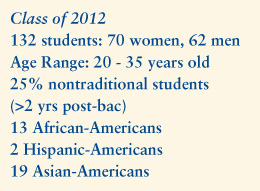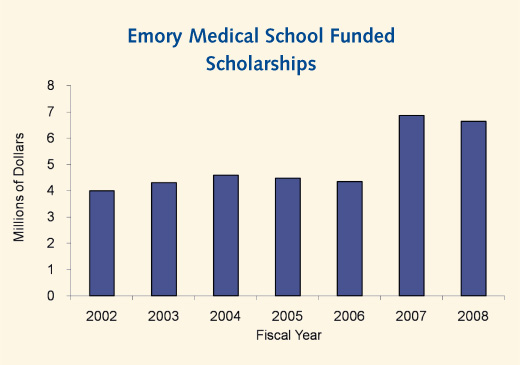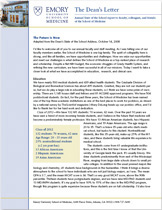Education

We have nearly 500 medical students and 439 allied health students. The Graduate Division of Biological and Biomedical Sciences has about 495 students. Granted, they are not our students per se, but we do play a large role in educating these students, so I think we have some pride of ownership. There are 1,145 house staff and fellows and 81 ACGME-approved programs. We have 504 postdoctoral students. (In fact, for the past three years, the School of Medicine has been named one of the top three academic institutions as one of the best places to work for postdocs, as shown by a national survey by The Scientist magazine.) Mary DeLong heads up our postdoc office, and I’d like to thank her for her hard work and dedication.
Class of 2012
We have 132 M1 students: 70 women, 62 men. Over the past 10 years we have seen a trend of more incoming female students, and I believe in the future that medicine will become a predominately female profession. We have 13 African American students, two Hispanic Americans, and 19 Asian Americans. The age range is 20 to 35. That’s a brave 35-year-old who starts medical school, but kudos to this student. Nontraditional students, like this 35-year-old, make up 25% of the M1 class, and these students bring valuable life experience to medical school.
The students come from 61 undergraduate institutions, and this is the first time I know of that the University of Georgia leads the pack. It’s usually Emory. We draw students predominantly from east of the Mississippi River, ranging from large state schools down to small private colleges. In addition to the usual premed majors like biology and chemistry, 41 students have backgrounds in the humanities. I think it brings a diverse atmosphere to the school to have individuals who are not just biology majors, as I was. The mean GPA is 3.7, and the mean MCAT score is 34. That’s a very good MCAT score, above the 90th percentile. Thirteen students have postgraduate degrees, and we have nine MD/PhD students and 13 MD/MPH students. It’s my goal to have 10% to 15% of the class in the MD/PhD program, though this program is quite expensive because these students are on full scholarship. I’d also love to be able to have 25% of the class in the MD/MPH program, but we have a little more work to do to reach that goal. Thank you to all those who are heavily involved with this class: Ira Schwartz, William Eley, Alan Otsuki, Gordon Churchward, and Robert Lee.

I know all of you are concerned, as am I, about student debt. Along with other deans, I have spent a great deal of time raising funds to increase scholarship money. Scholarships allow us to admit any qualified student and to give students enough money so that debt at graduation is not crippling. We want students to have the choice to practice any specialty in any area, including rural or urban areas, where they may not earn as much as in other locations. For students to consider those choices, we have to make sure they don’t graduate with crushing debt. We have made progress, particularly over the past couple of years, in increasing scholarship money, the majority of which comes from our alumni. They understand the value of an Emory education and how important it is to graduate with only a modest amount of debt. We were able to give away $6.6 million last year, and we are hoping to give away more in the coming years.
LCME Accreditation
We went through this cycle in March 2008. The LCME team and board members thought our leadership was very good and our financial position, solid. Student advocacy, particularly HealthSTAT, was noted as excellent. They were, of course, very impressed by the medical education building. They also complimented us on our research enterprise and opportunities provided for students to work with investigators.
There are three areas on which we need to improve, though. I can tell you that if a school gets only three areas cited, it is doing very well. (I sit on the LCME board that adjudicates the reviews, although I recused myself for our review.) We were cited for having relatively little outpatient experience. It is true that some of our major rotations are almost exclusively inpatient, and those are being revised.
Another area for us to improve is the timely return of student grades for classes. There were a couple of courses in which the students had to wait a couple of weeks to receive their grade. We have talked to the chairs of the departments involved, and that matter has been resolved. Last, LCME said there was a relative lack of awareness among students about the school’s policy on student mistreatment. LCME knows that we have such policies in place and that they have been distributed to students. But the policies were little known to students. So we will press forward with another mechanism to increase students’ awareness.
I thought these items were pretty minor, so kudos to our LCME steering committee for helping prepare this report, which was a massive undertaking. It took between 12 to 18 months to put together the required information and documents. The individuals who deserve special thanks for this are Alan Otsuki, who headed up the process as associate dean for medical education, and Jennifer McCormick, associate director for medical education. In addition, emergency medicine chair Kate Heilpern played a key role, and it goes without saying that William Eley deserves thanks, as well as the many chairs who devoted their time.
Teaching Excellence Awards
Before I move onto research, I wanted to mention the winners of this year’s teaching excellence awards. These individuals are nominated by their peers, students, or residents, and all nominations then go to a committee, which renders the final choices. This year there are seven awardees, and they represent a wide cross-section of departments: Erica Brownfield, medicine; Victor Faundez, cell biology; Nicolas Krawiecki, human genetics and pediatrics; Kimberly Manning, medicine; S.R. Panini, biochemistry; Douglas Parker, pathology; and Winfield Sale, cell biology. These are extremely dedicated, accomplished teachers who deserve our thanks.

